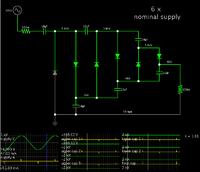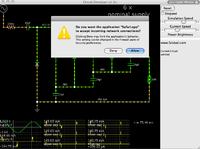jegues
Member level 3

- Joined
- May 29, 2011
- Messages
- 58
- Helped
- 0
- Reputation
- 0
- Reaction score
- 0
- Trophy points
- 1,286
- Activity points
- 1,915
I have used PSCAD to simulate the circuit, but the use of any other circuit simulator should provide similiar results.
Attached is a picture of the circuit, and my PSCAD file.
First off, I build the circuit within PSCAD and input all of my source and component values. After doing so I have come across a number of problems, some of which I've attempted to fix and others for which I am clueless.
Problem 1: For my "Single Phase Voltage Source" I put in a voltage of 1kV because I desired a voltage with an amplitude that varies from +1kV to -1kV. When I had displayed the source output on the graph it looked at though the source was fluctuating between ~+/-1.4kV. Why is this, and how do I achieve my desired amplitude of 1kV? (For now I simply used trial and error to achieve a AC source of ~1kV amplitude, it required and input of ~0.72kV)
Problem 2: The circuit is not providing the correct output voltage, and I can't figure out why. I haven't changed anything within the diode settings except not to use the snubber circuitry. Furthermore, I measured V2p and V3p and found them to be identical waveforms to Vo. Ideally, Vo should sit somewhere around 2*n*Vs, where n is the number of stages. Since I used n=3 stages, I expect a voltage slightly below 6kV, but I am seeing a voltage of a mere 1kV. What is going on here?
Problem 3: Assuming I can get the circuit functioning properly, I want to make numerous measurements by varying one variables (i.e. f, C, load resistance etc...) and holding the others constant. Assume I had 3 different values for each variable that I wanted to test, this would leave me with 27 (3*3*3) circuits to reconfigure and measure. Is there a way where I can test all the different combinations of parameters while only building one circuit and have PSCAD tabulate the results for me? (Or something similar to make my life easier?)
Any insight/suggestions/comments/corrections on either of these problems would be greatly appreciated!
Thanks for your time!
Cheers!
 View attachment Cockcroft-Walton.zip
View attachment Cockcroft-Walton.zip
Attached is a picture of the circuit, and my PSCAD file.
First off, I build the circuit within PSCAD and input all of my source and component values. After doing so I have come across a number of problems, some of which I've attempted to fix and others for which I am clueless.
Problem 1: For my "Single Phase Voltage Source" I put in a voltage of 1kV because I desired a voltage with an amplitude that varies from +1kV to -1kV. When I had displayed the source output on the graph it looked at though the source was fluctuating between ~+/-1.4kV. Why is this, and how do I achieve my desired amplitude of 1kV? (For now I simply used trial and error to achieve a AC source of ~1kV amplitude, it required and input of ~0.72kV)
Problem 2: The circuit is not providing the correct output voltage, and I can't figure out why. I haven't changed anything within the diode settings except not to use the snubber circuitry. Furthermore, I measured V2p and V3p and found them to be identical waveforms to Vo. Ideally, Vo should sit somewhere around 2*n*Vs, where n is the number of stages. Since I used n=3 stages, I expect a voltage slightly below 6kV, but I am seeing a voltage of a mere 1kV. What is going on here?
Problem 3: Assuming I can get the circuit functioning properly, I want to make numerous measurements by varying one variables (i.e. f, C, load resistance etc...) and holding the others constant. Assume I had 3 different values for each variable that I wanted to test, this would leave me with 27 (3*3*3) circuits to reconfigure and measure. Is there a way where I can test all the different combinations of parameters while only building one circuit and have PSCAD tabulate the results for me? (Or something similar to make my life easier?)
Any insight/suggestions/comments/corrections on either of these problems would be greatly appreciated!
Thanks for your time!
Cheers!
 View attachment Cockcroft-Walton.zip
View attachment Cockcroft-Walton.zip
Last edited:





